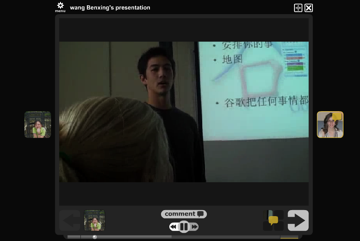Dan Wang, Instructor, Asian and Middle Eastern Studies
Dan Wang was one of fourteen faculty and one graduate student who participated in a Spring 2010 CIT Fellowship for language faculty interested in exploring with colleagues the most effective and most efficient ways to increase students’ oral production in the target language, in order to increase students’ language learning.
Wang was seeking a tool that would allow students in her Chinese 126 course to:
- regularly voice their opinions and exchange ideas with each other after class in Chinese;
- reflect on their learning activities and instructional materials in class;
- interact in Chinese in a new medium (student to student and instructor to student interactions);
- be exposed to authentic communication by interaction with native speakers;
- apply their newly-learned knowledge and skills to real situations.
To accomplish these goals, she decided to use VoiceThread for four types of course activities: interviews with native speakers, skit performance, movie journaling and oral presentation. VoiceThread was an appropriate tool for these activities because it allows group conversations to be collected and shared in one place, from anywhere. The 13 students in the class were broken into groups of 3 or 4 students each, which allowed them to collaborate on group projects by uploading content, adding comments, and discussing assignments together.
Activity 1: interviews with native speakers
This activity was carried out a cycle of three tasks: 1) a pre-task to expose students to reading materials that related to the course in order to understand the background of a hot topic in China; 2) a core task in two parts: interview native speakers, record the interview with Flip video cameras and post on VoiceThread, and then present an interview summary orally with webcam or microphone on Voicethread for fellow students and instructor to hear; 3) a post-task which required students to listen to/view group members’ presentations and leave comments.
Activity 2: Skit performance
At the end of the semester, each group was required to choose one topic related to the chapters learned in class and design a public-interest advertisement. After revising the script, the groups performed this skit and recorded it using Flip cameras. Each group then posted the video clip to VoiceThread, and everyone was required to view at least one advertisement from another group and leave voice comments.
Activity 3: Movie journaling
Students were assigned to watch two relevant Chinese movies outside of the classroom, then answer several questions posted by the instructor in VoiceThread, listen to their classmates’ responses, compare their responses to their classmates’, and have a short in-class discussion the next day.
Activity 4: Oral presentation
Every Friday in class, one student gave an oral presentation, which was recorded and posted in VoiceThread. This allows time outside of class for review, discussion and feedback: The presenter must view his/her presentation after class and fill out a self-assessment form, and his/her group members also fill out a peer evaluation and leave comments.
At the end of semester, Wang administered a survey to students, and was encouraged that 90% of the respondents welcome the use of VoiceThread. Their comments included:
- good user interface, fun to make project
- it is interesting to hear people’s response; it is also helpful on identifying errors.
- it was good to be able to see my presentation and be able to self evaluate my Chinese pronunciation
- very cool, easy to use
- I could watch myself and see where I went wrong
- has a lot of potential
- I can learn my own weaknesses
- allows speaking practice
- let you use language outside of classroom
- provides an opportunity to get a lot of feedback
Several students expressed concerns about the 100 Mb upload limit, and mentioned that they had had technical difficulties using VoiceThread.
Wang plans to use VoiceThread in future with a few adjustments, due to its advantages for her course:
- Encouraging active participation in target language use regardless of distance and space; stored-and-forward communication is easily accessible;
- Promoting the use of multiple communication modes from receptive to productive and interpersonal, interpretive and presentational communication;
- Providing a wide range of participation from one-to-one, one-to-many and many-to-many;
- Making good use of multiple communication devices to extend maximum language contact hours and frequency of interaction among teachers and students and between native speakers and non-native speakers;
- Providing an opportunity to get a lot of feedbacks and the student’s productive samples were collected for assessment.
Best practices or lessons learned for other faculty:
- Rubrics are very important for providing assessment;
- Students appreciate getting feedback from both the instructor and their classmates;
- Design the course to include more ungraded activities in the future (in this semester, she graded all the activities, which was time-consuming).




